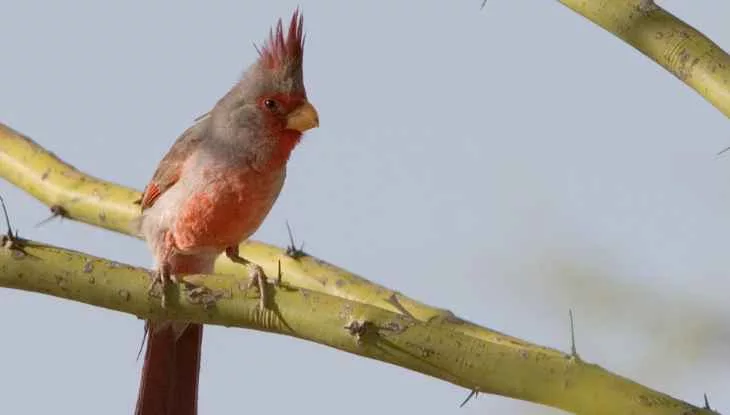
If you want to know about types of Cardinals and see them you have to travel long distances. No worries that’s why I am here to tell you every piece of information about them to add it to your list.
In this article, we will talk about what are cardinals. all the types of Cardinals, Where do Northern Cardinals Live? What are Northern Cardinals Like? and everything about them.
What are Cardinals?
Whether observed in backyard feeders or within the depths of dense woodlands, cardinals serve as ambassadors of nature’s wonders, inviting us to appreciate the biodiversity that enriches our surroundings.
As I have seen, Cardinals are medium-sized about 8 to 9 inches (20 to 23 cm) in length, and renowned for their brilliant red plumage which extends over their bodies and heads, they may vary in color intensity, and females may have a little difference in terms of color which adds a good brown touch to their bodies.
The red color and the crest on their heads make them easy to spot for birdwatchers as you can know them from long distances through binoculars.
they are known for loving their habitat, and you have to know that can attack any bird who is coming closer to their habitat.
Types of Cardinals
The Cardinalidae family has over 40 recognized species including cardinals, grosbeaks, and allies but today I will talk with you about the 3 Different types of Cardinals mentioning the differences between them to make them easy to spot.
1. Northern Cardinal
Northern Cardinals with their red color bring happiness and enjoyment to your day when you see it so you have to be happy my friend.
They’re the most well-known cardinals, and their habitat is usually the eastern part of the United States.
This bird exists only in some states but he is a lover bird worldwide as many people travel to see it.
You can see it on the snow giving a beautiful red touch to nature.

Where do Northern Cardinals Live?
Their name can tell you where they live “Northern Cardinals” as they can travel over the north to Canada.
Northern Cardinals don’t immigrate and leave their habitat for weather reasons because you can see them even though the weather is very cold or hot.
The only reason that makes them immigrate is the food availability, when they’re in a place where food is little, then they decide to change their habitat looking for a good living place.
So, If they appear someday near your birdfeeder, go and let them eat from it. If they feel safe and the food is available there, will stay over the year living near your house and eat from your birdfeeder.
What are Northern Cardinals Like?
Northern Cardinals are aggressive and known to protect their habitat as males can attack any other species that are trying to come closer to their habitat or their females.
You may see a northern Cardinal attack your window or when he is drinking in a river hit his head in the water and you’re wondering why they’re doing this.
Well, let’s put it this way, they attack your window or hit their heads in the water because they see their reflection and consider it dangerous because as you know animals and birds don’t know something called reflection.
In the morning when I was in the hotel at the Michigan State Ann Arbor, I saw a Northern Cardinal trying to break the windows of my room, but after thinking about this action and searching about it I found that he attacked the reflection of his self.
Even though they are aggressive with other birds they are not the same with humans.
To protect themselves from human activities and wild birds or animals they build their nests in the dense foliage and low trees, because firstly protect it from wild birds and secondly from the cold weather.
When you see these beautiful birds singing that means they’re are saying to other birds “This is our place don’t come closer” By singing they will know if there are any other birds in their habitat.
Regardless of whether they poop many times a day like other birds, they love to eat Sunflower Seeds.
Breeding Information About Northern Cardinals
In late winter or early spring, the breeding season of Northern Cardinals starts, and then you will see males singing and dancing for females in trees or near windows, it’s the season when you can hear the music of nature everywhere.
Away from what other birds doing, the Northern Cardinal breeding season is from March to September and the mating season is from May to July.
During this period, they may engage in broods, within a single season. by a single breeding pair in a single nesting attempt. Cardinals may build nests in shrubs, vines, or low trees, and the female typically lays a clutch of eggs in each nesting attempt.
Northern Cardinals typically lay 3 to 4 eggs, although it can sometimes range from 2 to 5 eggs.
Their eggs are generally pale green or blue with small brown speckles, and they are laid in a cup-shaped nest constructed by the female.
After laying the eggs, the incubation period lasts for approximately 11 to 13 days. During this time, the female cardinal is primarily responsible for keeping the eggs warm by sitting on the nest.
The role of the male is to support the female during incubation by providing food, and ensuring she receives the necessary nutrition to sustain herself and the developing embryos.
Sometimes, the male can incubate eggs and let the female fly a little and get some food.
What Color are Northern Cardinals?
So, what color are Northern Cardinals? The answer is simple yet breathtaking: they are a brilliant, eye-catching red. Imagine a burst of color against a backdrop of green leaves or a blanket of snow—this is the Northern Cardinal making its grand entrance into your world.
The feathers of males boast a shade of red so vivid, this color is not only beautiful but contains also a love message for us.
Now, you might be wondering, what about the females? Well, Female Northern Cardinals sport a more subtle combination of tan and brown tones, allowing them to blend in seamlessly with their surroundings. This helps them stay discreet while nesting and caring for their young.
There is a period when they shed their feathers but it is so short and this is the only case where they lose their color relatively, then they restore their color.
A yellow cardinal has previously been seen by some birdwatchers but this is an exceptional and rare case because the reason for the yellow color is a genetic condition called xanthochroism which is a genetic mutation that affects the way pigments are deposited in feathers.
What do Northern Cardinals Sound like?
Both the male and female Northern Cardinals are capable of singing. Their song is characterized by a loud sequence of distinct down-slurred or two-parted whistles, frequently accelerating and concluding with a gradual trill.
Typically, these songs endure for 2 to 3 seconds, and the syllables may resemble expressions such as “cheer, cheer, cheer”, “birdie, birdie, birdie. or “few, few, few”
Northern Cardinals are singing a lot, especially in the mating period to attract females or females attract males or when they are protecting their habitat.
2. Vermilion Cardinal

The Vermilion Cardinal, scientifically known as Cardinalis phoeniceus, a charming bird native to South America, is quite the eye-catcher with its bright red feathers if it’s a guy.
The ladies, on the other hand, rock a more subtle look in olive and brown. You can find these birds hanging out in thick bushes and forests.
They’re not just pretty faces; they’re also good at singing and love to socialize. Picture them as nature’s little pops of color, adding a touch of beauty to their home turf.
They’re the same as Northern Cardinals with a head crest with a few differences in their body color.
Where do the Vermilion Cardinals Live?
Vermilion cardinals primarily inhabit South America and you can find it also in regions such as Venezuela, Colombia, Brazil, and parts of Ecuador.
These places often have dense shrubbery and forest edges that offer ample vegetation for nesting and provide shelter, protecting them from predators and environmental elements.
the other reason why they choose these places to live is because they offer a diverse array of plant life and insect populations, ensuring a stable and varied food supply.
It’s suitable also for nest-building for Vermilion Cardinals because they build it in concealed locations, helping to safeguard their eggs and chicks from potential threats.
South America’s tropical and subtropical climates provide conditions that are favorable for Vermilion Cardinals. The temperature ranges and environmental characteristics of these regions align with the species’ preferences.
What are Vermilion Cardinals Like?
Vermilion is not too much different from Northern Cardinals, they are different only in some points like color, and habitat as Vermillion Cardinals are found primarily in South America, and Northern Cardinals are primarily found in North America and Canada.
Vermilion Cardinals are smaller than Northern Cardinals in size and they are non-migratory birds opposite of Northern Cardinals that may immigrate to small distances.

Breeding information about Vermilion Cardinals
These cardinals truly care for their little ones. The time when they start a family runs from June to early August. During this period, both the mommy and daddy cardinals take turns providing food for their youngsters.
Normally, they have about 3 to 4 baby birds each time, and in many instances, they manage to raise 2 to 3 groups of chicks within a year. Despite the arrival of these extra babies, the cardinals face difficulties due to losing their homes and the impact of climate change on their lives. Interestingly, they are skilled at using warm air currents to glide around, searching for the perfect place to build a nest!
What Color are Vermilion Cardinals?
The color of Vermilion Cardinals are red looks similar to Northern Cardinal as it’s difficult for some beginner birdwatchers to distinguish Because they’re the same in shape of their bodies and size, but the body of a vermillion Cardinal is red and have a little black on its wings and around his face.
3. Pyrrhuloxia or Desert Cardinal

In the desert, where things can be tough, this bird quietly teaches us about staying strong and graceful, even in the harshest places. The Desert Cardinal, with its unassuming charm, is like a wise friend in the vast desert landscape.
Meet the Pyrrhuloxia, also known as the Desert Cardinal—a bird that’s become my favorite among cardinals. It’s not flashy like its colorful cousins, but there’s something special about its low-key charm.
This bird has a mix of light grays, rusty reds, and soft pinks in its feathers, creating a kind of quiet beauty. Instead of standing out, it fits right into the desert, showing off its ability to handle tough conditions. Picture a bird that doesn’t shout for attention but still manages to steal your heart.
Watching Pyrrhuloxia is like finding a hidden treasure in nature. It’s not loud, but it has this simple beauty that makes you stop and appreciate it.
Where do Pyrrhuloxia Live?
The Pyrrhuloxia finds its home in the southern reaches of the United States, with notable populations in regions such as Texas, New Mexico, and Arizona. Its prevalence extends significantly into Mexico, covering the northern to the central parts of the country and encircling the Sierra Madre range.
This bird, true to its name, can stay in very difficult areas like the hot desert environments, showcasing adaptability in diverse landscapes, including mesquite savannas, woodlands, scrublands, and even farm fields. This adaptability allows the Pyrrhuloxia to endure both the searing heat and the chill of its surroundings.
The habitats offer an optimistic omnivore call home and provide an abundance of food. Its diet reflects this adaptability, encompassing insects, bugs, fruits, seeds, and nuts. The Pyrrhuloxia’s versatility in sustenance is key to its survival in environments ranging from arid deserts to more vegetated landscapes. Notably, 63% of the breeding population resides in Mexico, with the remaining 37% inhabiting the United States.
Unfortunately, this resilient species faces challenges, as its population of only 3 million is on the decline due to habitat loss.
For those seeking to spot this remarkable bird, remember to gaze skyward, as the Pyrrhuloxia delights in perching on tall trees and cactuses, offering a picturesque sight amidst its chosen habitats.
What are Desert Cardinals Like?
The Pyrrhuloxia exhibits behavior akin to other cardinals previously discussed. It asserts its territorial dominance over its nest and surrounding area, displaying agitation and aggression in the face of perceived threats.
This bird displays curiosity, often flying around in search of food on the ground near trees, shrubs, and other plant life. Additionally, it has been observed pilfering and consuming fruits from local farms, though the motive behind this behavior remains uncertain. Perhaps it is a response to perceived encroachment on their habitat by farmers, though this is speculative.
Furthermore, the Pyrrhuloxia possesses a melodious song, employed for attracting potential mates or defending its territory. Similar to other cardinals, specific songs convey information to mates, such as prompting the male to bring back food or indicating the presence of an intruding male. This communication aspect adds a human touch to their interactions, highlighting the importance of effective communication, even in the avian world.
Breeding Information About Pyrrhuloxia
Pyrrhuloxia breeding is a straightforward yet crucial aspect of their lifecycle. These birds typically engage in breeding activities during the spring and summer months, aligning with the favorable weather conditions for nesting and raising their young.
To initiate the breeding process, males of desert Cardinals use their songs as a means of attracting females. The intricate melodies serve as a form of communication, signaling their readiness to mate and establishing territorial boundaries. Females, in turn, are known to be selective, often choosing mates based on the quality of their songs and the suitability of their territory.
Once a pair has formed, they collaborate in building a nest, which is usually situated in dense shrubs or trees for protection. The female takes an active role in constructing the nest, using a combination of twigs, leaves, and other plant materials. The result is a well-hidden and sturdy structure that provides a secure environment for nesting and raising offspring.
After the nest is complete, the female lays a clutch of eggs, typically ranging from two to four. The incubation period follows, during which both parents take turns keeping the eggs warm. This shared responsibility reflects a cooperative effort in the Pyrrhuloxia breeding process.
Upon hatching, the parents continue to work together in caring for the chicks. They diligently feed the hatchlings a diet primarily composed of insects and seeds, ensuring the young birds receive the necessary nutrients for growth and development. This collaborative parenting approach enhances the chances of offspring survival.
As the chicks mature, they gradually fledge and become more independent. The breeding cycle of the Pyrrhuloxia thus encapsulates a series of well-coordinated behaviors, from courtship and nest-building to shared incubation and cooperative parenting, ensuring the continuity of their species.
What Color are Pyrrhuloxia Cardinals?

The coloration of Pyrrhuloxia cardinals, particularly the muted gray tones of the females and the subdued red accents on the males, carries a certain understated beauty. There’s a simplicity in their appearance that resonates with a quiet appreciation. The gray-brown feathers of the females seem to blend seamlessly with the environment, providing a sense of practicality and natural elegance.
The males, with their touches of red on the crest, face, and breast, add a subtle yet distinctive charm. There’s a sense of balance in their coloration, a quiet confidence that doesn’t demand attention but still leaves an impression. It’s a color palette that mirrors the calm and composed nature of the bird itself, fitting seamlessly into the landscape without any ostentation.
In observing these cardinals, one can’t help but appreciate the unassuming beauty of their plumage. It’s a reminder that sometimes, it’s the subtle and muted aspects of nature that draw us in, inviting a contemplative connection rather than an overt display of brilliance. The Pyrrhuloxia’s coloration, in its quiet simplicity, evokes a sense of harmony and grace in the natural world.
